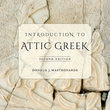 Pronunciation Guide
Pronunciation Guide

|
|
The information presented here is essentially the same as the core information in Unit 1 of Introduction to Attic Greek, but broken into smaller chunks and provided with audio examples. The aim is to discuss the pronunciation of Attic Greek in the 5th and 4th centuries B.C.E. Pronunciation was shifting during this period, and shifted further over the following centuries of the history of Greek. The discussion is indebted to W. Sidney Allen, Vox Graeca: a Guide to the Pronunciation of Classical Greek (3rd edition, 1987) and other sources. The recommendations given here reflect a commonly-adopted pedagogically practical compromise involving the admixture of the treatment of some sounds as they developed in late classical or postclassical pronunciation. One may attempt a more purist pronunciation (for instance of theta and phi), but this has been found to cause many students to commit spelling errors that are avoided with the compromise system. In the following, a letter or group of letters in square brackets, such as [u], represents a phonetic transcription based on conventional values in the International Phonetic Alphabet (IPA). |
||||||||||||||||||||||||
| BEGIN | |||||||||||||||||||||||||
|
In this (June 2015) revision of the pronunciation modules, the sounds have been converted to mp3 format and are played directly from a javascript command, without the need for the Quicktime plugin. Up-to-date browsers should have no trouble playing the sounds. And they play on iOS devices (and perhaps on Android devices as well). If you are stuck with an old browser for some reason, the older version of Pronunciation Guide (requiring Quicktime plugin) can be accessed by clicking this link. | |||||||||||||||||||||||||
| BEGIN |